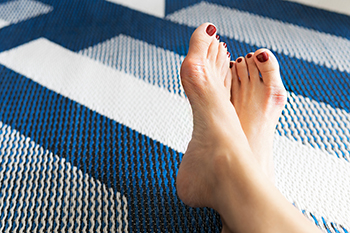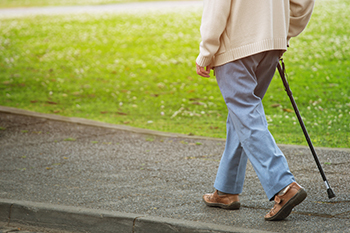December 2022
Causes of Pain on the Inside of the Foot

One of the most common causes of pain on the inside of the foot is posterior tibial tendonitis. It occurs when the all-important posterior tibial tendon becomes inflamed, usually from overuse. This tendon starts in the back of the leg, runs under the ankle, and attaches to the inside of the foot. The posterior tibial tendon helps to slow you down as your foot hits the ground and then pushes you forward with each step. If that motion is repeated during a workout, or if your feet flatten too much as you walk or run, the posterior tibial tendon can become overworked and painful. One way to stop this from happening is to find footwear that helps to stabilize the foot, support the arch, and keep the foot from rolling inward. Another way is to be fitted by a podiatrist for custom orthotics. It is important to note that substantial pain under the foot may indicate a torn tendon, and you may wish to seek immediate medical attention. If you are experiencing pain on the inside of the foot, it is a good idea to consult a podiatrist to determine the cause and get the proper treatment for you.
Foot Pain
Foot pain can be extremely painful and debilitating. If you have a foot pain, consult with Gregory T. Loo, DPM from Elite Podiatry. Our doctor will assess your condition and provide you with quality foot and ankle treatment.
Causes
Foot pain is a very broad condition that could be caused by one or more ailments. The most common include:
- Bunions
- Hammertoes
- Plantar Fasciitis
- Bone Spurs
- Corns
- Tarsal Tunnel Syndrome
- Ingrown Toenails
- Arthritis (such as Gout, Rheumatoid, and Osteoarthritis)
- Flat Feet
- Injury (from stress fractures, broken toe, foot, ankle, Achilles tendon ruptures, and sprains)
- And more
Diagnosis
To figure out the cause of foot pain, podiatrists utilize several different methods. This can range from simple visual inspections and sensation tests to X-rays and MRI scans. Prior medical history, family medical history, and any recent physical traumatic events will all be taken into consideration for a proper diagnosis.
Treatment
Treatment depends upon the cause of the foot pain. Whether it is resting, staying off the foot, or having surgery; podiatrists have a number of treatment options available for foot pain.
If you have any questions, please feel free to contact one of our offices located in Ahwatukee, and Phoenix, AZ . We offer the newest diagnostic and treatment technologies for all your foot care needs.
What Is a DPM?

If an individual wants to pursue a career in medicine and eventually become a doctor, that individual must typically undergo a rigorous course of study to obtain a degree in medicine. There are doctors of all kinds, and depending on which kind of doctor someone wants to become, they will have to pursue a specialized, specific degree. People that want to become podiatrists, for example, must pursue the degree of Doctor of Podiatric Medicine. This credential is commonly shortened to simply DPM. Podiatrists are very helpful and useful medical professionals that can help you identify and treat a wide range of problems that might be affecting your feet. For example, the DPM might be able to help you treat a case of plantar fasciitis, plantar warts, or toenail fungus, among other things. Schedule an appointment with a podiatrist today for more information.
If you are experiencing pain in the feet or ankles, don’t join the stubborn majority refusing treatment. Feel free to contact Gregory T. Loo, DPM from Elite Podiatry. Our doctor can provide the care you need to keep you pain-free and on your feet.
What Is a Podiatrist?
Someone would seek the care of a podiatrist if they have suffered a foot injury or have common foot ailments such as heal spurs, bunions, arch problems, deformities, ingrown toenails, corns, foot and ankle problems, etc.
Podiatric Treatment
A podiatrist will treat the problematic areas of the feet, ankle or lower leg by prescribing the following:
- Physical therapy
- Drugs
- Orthotic inserts or soles
- Surgery on lower extremity fractures
A common podiatric procedure a podiatrist will use is a scanner or force plate which will allow the podiatrist to know the designs of orthotics. Patients are then told to follow a series of tasks to complete the treatment. The computer will scan the foot a see which areas show weight distribution and pressure points. The podiatrist will read the analysis and then determine which treatment plans are available.
If you have any questions please feel free to contact one of our offices located in Ahwatukee, and Phoenix, AZ . We offer the newest diagnostic and treatment technologies for all your foot and ankle needs.
What Caused My Bunion?

A bunion is a deformity of the joint at the base of the big toe. Bunions develop when the first metatarsal bone of the foot turns outward and the big toe points inward toward the other toes. This causes the joint to extend out from the foot. A bunion can become painful and interfere with walking and exercising as the joint becomes inflamed. It can be difficult to find shoes that accommodate a bunion, and it is best to avoid any additional pressure on the misaligned joint. Women are more likely to develop bunions because they tend to wear narrow shoes and high heels. Bunions can also be genetic and may result due to abnormal foot structures and shapes. Those with low arches and loose joints or tendons, as well as people who stand on their feet for prolonged periods, are also at increased risk for developing bunions. If you have a painful bunion, it is suggested you see a podiatrist who can provide alternative treatment options to help you live more comfortably.
If you are suffering from bunion pain, contact Gregory T. Loo, DPM of Elite Podiatry. Our doctor can provide the care you need to keep you pain-free and on your feet.
What Is a Bunion?
Bunions are painful bony bumps that usually develop on the inside of the foot at the joint of the big toe. As the deformity increases over time, it may become painful to walk and wear shoes. Women are more likely to exacerbate existing bunions since they often wear tight, narrow shoes that shift their toes together. Bunion pain can be relieved by wearing wider shoes with enough room for the toes.
Causes
- Genetics – some people inherit feet that are more prone to bunion development
- Inflammatory Conditions - rheumatoid arthritis and polio may cause bunion development
Symptoms
- Redness and inflammation
- Pain and tenderness
- Callus or corns on the bump
- Restricted motion in the big toe
In order to diagnose your bunion, your podiatrist may ask about your medical history, symptoms, and general health. Your doctor might also order an x-ray to take a closer look at your feet. Nonsurgical treatment options include orthotics, padding, icing, changes in footwear, and medication. If nonsurgical treatments don’t alleviate your bunion pain, surgery may be necessary.
If you have any questions, please feel free to contact one of our offices located in Ahwatukee, and Phoenix, AZ . We offer the newest diagnostic and treatment technologies for all your foot care needs.
Arthritis Can Cause Pain in the Feet and Ankles
Caregivers and Fall Prevention Practices

There are many people who live in nursing homes or assisted living facilities, and it is important that fall prevention techniques are followed while in these types of environments. It is beneficial for caregivers to know the pain level of their patients, and this can help gauge if help is needed to walk. The risk of falling may be reduced when there is assistance while using the commode or shower, and crutches or other support devices are within reach. Additionally, when the patient's personal belongings are close to them, such as cell phones, glasses, TV remote, or reading materials, the chances of falling to retrieve these items is greatly reduced. The call button and light are essential in being easily accessed, and this may prevent the patient from getting out of bed to find a caregiver. If you would like additional information about how falling can affect the feet, a podiatrist can correctly inform you how this may be avoided with fall prevention techniques.
Preventing falls among the elderly is very important. If you are older and have fallen or fear that you are prone to falling, consult with Gregory T. Loo, DPM from Elite Podiatry. Our doctor will assess your condition and provide you with quality advice and care.
Every 11 seconds, an elderly American is being treated in an emergency room for a fall related injury. Falls are the leading cause of head and hip injuries for those 65 and older. Due to decreases in strength, balance, senses, and lack of awareness, elderly persons are very susceptible to falling. Thankfully, there are a number of things older persons can do to prevent falls.
How to Prevent Falls
Some effective methods that older persons can do to prevent falls include:
- Enrolling in strength and balance exercise program to increase balance and strength
- Periodically having your sight and hearing checked
- Discuss any medications you have with a doctor to see if it increases the risk of falling
- Clearing the house of falling hazards and installing devices like grab bars and railings
- Utilizing a walker or cane
- Wearing shoes that provide good support and cushioning
- Talking to family members about falling and increasing awareness
Falling can be a traumatic and embarrassing experience for elderly persons; this can make them less willing to leave the house, and less willing to talk to someone about their fears of falling. Doing such things, however, will increase the likelihood of tripping or losing one’s balance. Knowing the causes of falling and how to prevent them is the best way to mitigate the risk of serious injury.
If you have any questions, please feel free to contact one of our offices located in Ahwatukee, and Phoenix, AZ . We offer the newest diagnostic and treatment technologies for all your foot care needs.










